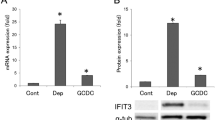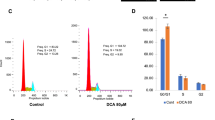Abstract
Background and Aims
Senescent cells can alter local tissue environments by secretion of various senescence-associated secretory phenotypes (SASP), such as cytokines and chemokines. Given senescent biliary epithelial cells (BECs) in damaged small bile ducts in primary biliary cirrhosis (PBC) show increased expression of chemokines CCL2 and CX3CL1 as SASP, we further examined an involvement of CCL2/CCR2 and CX3CL1/CX3CR1 systems in the pathogenesis of PBC.
Methods
We examined immunohistochemically the expression of CCR2, CX3CR1, CCL2 and CX3CL1 in livers taken from the patients with PBC (n = 45) and control livers (n = 78), such as chronic viral hepatitis (CVH; n = 39). CCR2 or CX3CR1-expressing cells were characterized by double immunofluorescence with CD3, CD4, CD8, CD56 or CD68.
Results
CCR2 is expressed in round cells, epithelioid cells and dendritic cells and most CCR2-positive cells were CD68-positive. Infiltration of CCR2-positive cells in the intraepithelial layer or around small bile ducts was significantly more extensive in PBC than CVH and normal liver (p < 0.05) and was significantly correlated with the expression of CCL2 in BECs (p < 0.01). Most CX3CR1-expressing inflammatory cells were CD3-positive T cells (CD8 > CD4). Infiltration of CX3CR1-positive cells in the intraepithelial layer and around small bile ducts was significantly more extensive in PBC than control livers (p < 0.05) and was significantly correlated with the expression of CX3CL1 in BECs (p < 0.05).
Conclusion
CCL2 and CX3CL1 produced by senescent BECs may promote infiltration of corresponding CCR2 and CX3CR1-expressing cells and further aggravate inflammation in bile duct lesion in PBC.



Similar content being viewed by others
References
Gershwin ME, Mackay IR, Sturgess A, Coppel RL. Identification and specificity of a cDNA encoding the 70 kd mitochondrial antigen recognized in primary biliary cirrhosis. J Immunol. 1987;138:3525–3531.
Kaplan M. Primary biliary cirrhosis. New Engl J Med. 1996;335:1570–1580.
Portmann B, Nakanuma Y. Diseases of the bile ducts. In: Ishak K, Scheuer P, Anthony P, MacSween R, Burt A, BC P, eds. Pathology of the Liver. London: Churchill Livingstone; 2001:435–506.
Nakanuma Y, Ohta G. Histometric and serial section observations of the intrahepatic bile ducts in primary biliary cirrhosis. Gastroenterology. 1979;76:1326–1332.
Sasaki M, Ikeda H, Yamaguchi J, Nakada S, Nakanuma Y. Telomere shortening in the damaged small bile ducts in primary biliary cirrhosis reflects ongoing cellular senescence. Hepatology. 2008;48:186–195.
Sasaki M, Ikeda H, Haga H, Manabe T, Nakanuma Y. Frequent cellular senescence in small bile ducts in primary biliary cirrhosis: a possible role in bile duct loss. J Pathol. 2005;205:451–459.
Sasaki M, Ikeda H, Nakanuma Y. Activation of ATM signaling pathway is involved in oxidative stress-induced expression of mito-inhibitory p21(WAF1/Cip1) in chronic non-suppurative destructive cholangitis in primary biliary cirrhosis: an immunohistochemical study. J Autoimmun. 2008;31:73–78.
Sasaki M, Ikeda H, Sato Y, Nakanuma Y. Decreased expression of Bmi1 is closely associated with cellular senescence in small bile ducts in primary biliary cirrhosis. Am J Pathol. 2006;169:831–845.
Lunz JG 3rd, Contrucci S, Ruppert K, et al. Replicative senescence of biliary epithelial cells precedes bile duct loss in chronic liver allograft rejection: increased expression of p21(WAF1/Cip1) as a disease marker and the influence of immunosuppressive drugs. Am J Pathol. 2001;158:1379–1390.
Krizhanovsky V, Yon M, Dickins RA, et al. Senescence of activated stellate cells limits liver fibrosis. Cell. 2008;134:657–667.
Plentz RR, Park YN, Lechel A, et al. Telomere shortening and inactivation of cell cycle checkpoints characterize human hepatocarcinogenesis. Hepatology. 2007;45:968–976.
Acosta JC, O’Loghlen A, Banito A, et al. Chemokine signaling via the CXCR2 receptor reinforces senescence. Cell. 2008;133:1006–1018.
Kuilman T, Michaloglou C, Vredeveld LC, et al. Oncogene-induced senescence relayed by an interleukin-dependent inflammatory network. Cell. 2008;133:1019–1031.
Wajapeyee N, Serra RW, Zhu X, Mahalingam M, Green MR. Oncogenic BRAF induces senescence and apoptosis through pathways mediated by the secreted protein IGFBP7. Cell. 2008;132:363–374.
Shelton DN, Chang E, Whittier PS, Choi D, Funk WD. Microarray analysis of replicative senescence. Curr Biol. 1999;9:939–945.
Coppe JP, Patil CK, Rodier F, et al. Senescence-associated secretory phenotypes reveal cell-nonautonomous functions of oncogenic RAS and the p53 tumor suppressor. PLoS Biol. 2008;6:2853–2868.
Sasaki M, Miyakoshi M, Sato Y, Nakanuma Y. Modulation of the microenvironment by senescent biliary epithelial cells may be involved in the pathogenesis of primary biliary cirrhosis. J Hepatol. 2010;53:318–325.
Nakanuma Y, Sasaki M. Expression of blood-group-related antigens in the intrahepatic biliary tree and hepatocytes in normal livers and various hepatobiliary diseases. Hepatology. 1989;10:174–178.
Ludwig J. Small-duct primary sclerosing cholangitis. Semin Liver Dis. 1991;11:11–17.
Desmet V, Gerber M, Hoofnagle J, Manns M, Scheuer P. Classification of chronic hepatitis: diagnosis, grading and staging. Hepatology. 1994;19:1513–1520.
Degre D, Lemmers A, Gustot T, et al. Hepatic expression of CCL2 in alcoholic liver disease is associated with disease severity and neutrophil infiltrates. Clin Exp Immunol. 2012;169:302–310.
Miura K, Yang L, van Rooijen N, Ohnishi H, Seki E. Hepatic recruitment of macrophages promotes nonalcoholic steatohepatitis through CCR2. Am J Physiol Gastrointest Liver Physiol. 2012;302:G1310–G1321.
Viebahn CS, Benseler V, Holz LE, et al. Invading macrophages play a major role in the liver progenitor cell response to chronic liver injury. J Hepatol. 2010;53:500–507.
Chiba M, Sasaki M, Kitamura S, Ikeda H, Sato Y, Nakanuma Y. Participation of bile ductular cells in the pathological progression of non-alcoholic fatty liver disease. J Clin Pathol. 2011;64:564–570.
Ohanna M, Giuliano S, Bonet C, et al. Senescent cells develop a PARP-1 and nuclear factor-{kappa}B-associated secretome (PNAS). Genes Dev. 2011;25:1245–1261.
Shimoda S, Harada K, Niiro H, et al. CX3CL1 (fractalkine): a signpost for biliary inflammation in primary biliary cirrhosis. Hepatology. 2010;51:567–575.
Isse K, Harada K, Zen Y, et al. Fractalkine and CX3CR1 are involved in the recruitment of intraepithelial lymphocytes of intrahepatic bile ducts. Hepatology. 2005;41:506–516.
Zhang W, Ono Y, Miyamura Y, Bowlus CL, Gershwin ME, Maverakis E. T cell clonal expansions detected in patients with primary biliary cirrhosis express CX3CR1. J Autoimmun. 2011;37:71–78.
de Vos AF, Pater JM, van den Pangaart PS, de Kruif MD, van ‘t Veer C, van der Poll Y. In vivo lipopolysaccharide exposure of human blood leukocytes induces cross-tolerance to multiple TLR ligands. J Immunol. 2009;183:533–542.
van ‘t Veer C, van den Pangaart PS, van Zoelen MA et al. Induction of IRAK-M is associated with lipopolysaccharide tolerance in a human endotoxemia model. J Immunol. 2007;179:7110–7120.
Acknowledgments
This study was supported in part by a Grant-in-Aid for Scientific Research (C) from the Ministry of Education, Culture, Sports and Science and Technology of Japan (24590409).
Conflict of interest
None.
Author information
Authors and Affiliations
Corresponding author
Rights and permissions
About this article
Cite this article
Sasaki, M., Miyakoshi, M., Sato, Y. et al. Chemokine–Chemokine Receptor CCL2–CCR2 and CX3CL1–CX3CR1 Axis May Play a Role in the Aggravated Inflammation in Primary Biliary Cirrhosis. Dig Dis Sci 59, 358–364 (2014). https://doi.org/10.1007/s10620-013-2920-6
Received:
Accepted:
Published:
Issue Date:
DOI: https://doi.org/10.1007/s10620-013-2920-6




